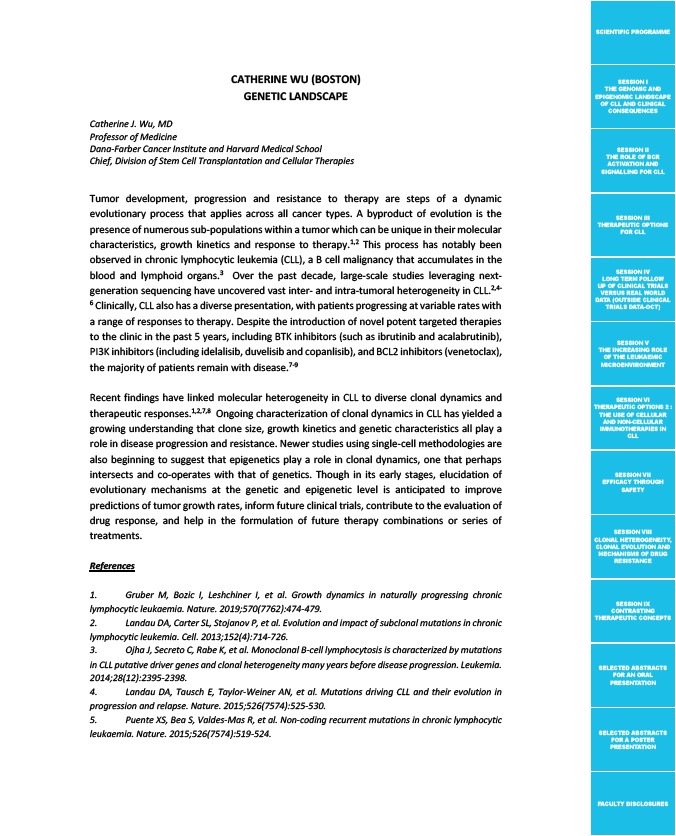
SCIENTIFIC PROGRAMME
SESSION I
THE GENOMIC AND
EPIGENOMIC LANDSCAPE
OF CLL AND CLINICAL
CONSEQUENCES
SESSION II
THE ROLE OF BCR
ACTIVATION AND
SIGNALLING FOR CLL
SESSION III
THERAPEUTIC OPTIONS
FOR CLL
SESSION IV
LONG TERM FOLLOW
UP OF CLINICAL TRIALS
VERSUS REAL WORLD
DATA (OUTSIDE CLINICAL
TRIALS DATA-OCT)
SESSION V
THE INCREASING ROLE
OF THE LEUKAEMIC
MICROENVIRONMENT
SESSION VI
THERAPEUTIC OPTIONS 2 :
THE USE OF CELLULAR
AND NON-CELLULAR
IMMUNOTHERAPIES IN
CLL
SESSION VII
EFFICACY THROUGH
SAFETY
SESSION VIII
CLONAL HETEROGENEITY,
CLONAL EVOLUTION AND
MECHANISMS OF DRUG
RESISTANCE
SESSION IX
CONTRASTING
THERAPEUTIC CONCEPTS
SELECTED ABSTRACTS
FOR AN ORAL
PRESENTATION
SELECTED ABSTRACTS
FOR A POSTER
PRESENTATION
FACULTY DISCLOSURES
CATHERINE WU (BOSTON)
GENETIC LANDSCAPE
Catherine J. Wu, MD
Professor of Medicine
Dana-Farber Cancer Institute and Harvard Medical School
Chief, Division of Stem Cell Transplantation and Cellular Therapies
Tumor development, progression and resistance to therapy are steps of a dynamic
evolutionary process that applies across all cancer types. A byproduct of evolution is the
presence of numerous sub-populations within a tumor which can be unique in their molecular
characteristics, growth kinetics and response to therapy.1,2 This process has notably been
observed in chronic lymphocytic leukemia (CLL), a B cell malignancy that accumulates in the
blood and lymphoid organs.3 Over the past decade, large-scale studies leveraging next-generation
sequencing have uncovered vast inter- and intra-tumoral heterogeneity in CLL.2,4-
6 Clinically, CLL also has a diverse presentation, with patients progressing at variable rates with
a range of responses to therapy. Despite the introduction of novel potent targeted therapies
to the clinic in the past 5 years, including BTK inhibitors (such as ibrutinib and acalabrutinib),
PI3K inhibitors (including idelalisib, duvelisib and copanlisib), and BCL2 inhibitors (venetoclax),
the majority of patients remain with disease.7-9
Recent findings have linked molecular heterogeneity in CLL to diverse clonal dynamics and
therapeutic responses.1,2,7,8 Ongoing characterization of clonal dynamics in CLL has yielded a
growing understanding that clone size, growth kinetics and genetic characteristics all play a
role in disease progression and resistance. Newer studies using single-cell methodologies are
also beginning to suggest that epigenetics play a role in clonal dynamics, one that perhaps
intersects and co-operates with that of genetics. Though in its early stages, elucidation of
evolutionary mechanisms at the genetic and epigenetic level is anticipated to improve
predictions of tumor growth rates, inform future clinical trials, contribute to the evaluation of
drug response, and help in the formulation of future therapy combinations or series of
treatments.
References
1. Gruber M, Bozic I, Leshchiner I, et al. Growth dynamics in naturally progressing chronic
lymphocytic leukaemia. Nature. 2019;570(7762):474-479.
2. Landau DA, Carter SL, Stojanov P, et al. Evolution and impact of subclonal mutations in chronic
lymphocytic leukemia. Cell. 2013;152(4):714-726.
3. Ojha J, Secreto C, Rabe K, et al. Monoclonal B-cell lymphocytosis is characterized by mutations
in CLL putative driver genes and clonal heterogeneity many years before disease progression. Leukemia.
2014;28(12):2395-2398.
4. Landau DA, Tausch E, Taylor-Weiner AN, et al. Mutations driving CLL and their evolution in
progression and relapse. Nature. 2015;526(7574):525-530.
5. Puente XS, Bea S, Valdes-Mas R, et al. Non-coding recurrent mutations in chronic lymphocytic
leukaemia. Nature. 2015;526(7574):519-524.